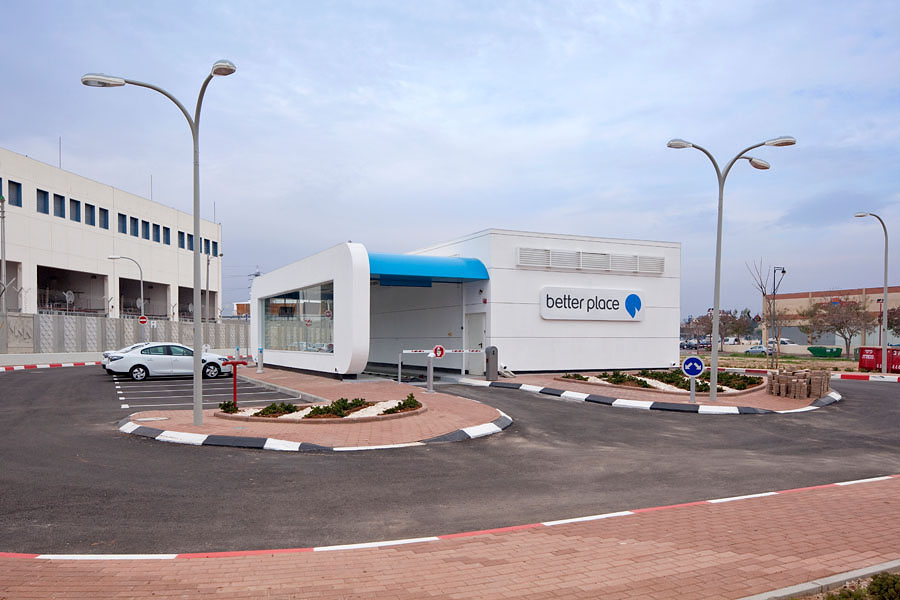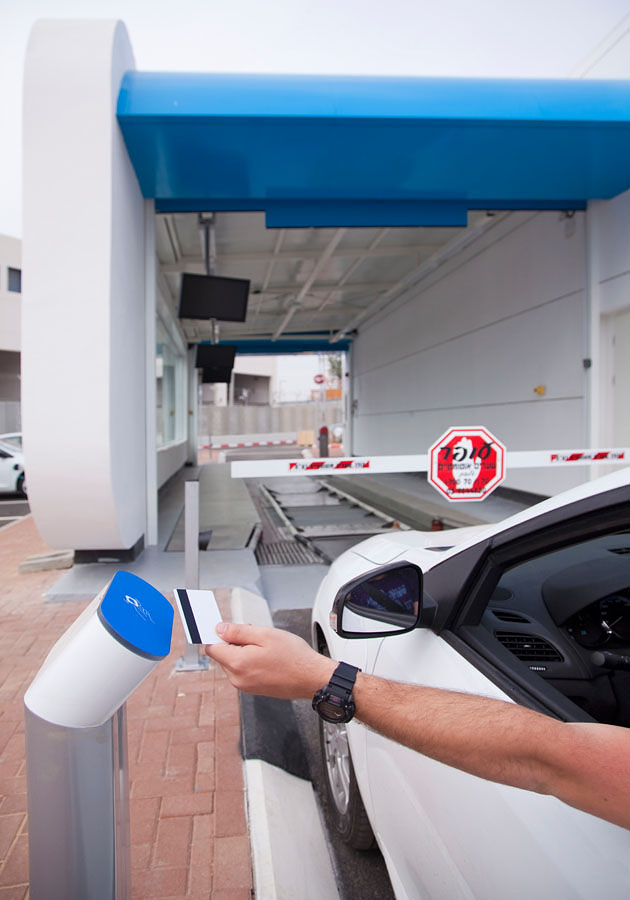Shown below is a copy of the recently released Annual Energy Outlook 2011. The projections in the Energy Information Administration’s (EIA) Annual Energy Outlook 2011 (AEO2011) focus on the factors that shape the U.S. energy system over the long term. Under the assumption that current laws and regulations remain unchanged throughout the projections, theAEO2011 Reference case provides the basis for examination and discussion of energy production, consumption, technology, and market trends and the direction they may take in the future. It also serves as a starting point for analysis of potential changes in energy policies. But AEO2011 is not limited to the Reference case. It also includes 57 sensitivity cases which explore important areas of uncertainty for markets, technologies, and policies in the U.S. energy economy.
The report’s section on Transportation offers quite a bit of information and I felt the readers would benefit quite a bit.. Take a look.
Growth in transportation energy use slower than historical trend
From 2009 to 2035, transportation sector energy consumption grows at an average annual rate of 0.6 percent (from 27.2 quadrillion Btu to 31.8 quadrillion Btu), slower than the 1.2 percent average rate from 1975 to 2009. The slower growth is a result of changing demographics, increased LDV fuel economy, and saturation of personal travel demand.
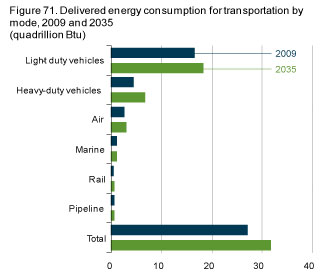 figure dataEnergy demand for LDVs increases by 10 percent, or 1.7 quadrillion Btu (1.3 million barrels per day), from 2009 to 2035 (Figure 71). Moderate growth in fuel prices compared with recent history and rising real disposable income combine to increase annual vehicle miles traveled (VMT), although personal travel demand increases at a slower rate than historically. Growth in delivered energy consumption by LDVs is tempered by more stringent standards for vehicle GHG emissions through model year (MY) 2016 and fuel economy through MY 2020. Energy demand for heavy-duty vehicles (including primarily freight trucks but also buses) increases by 48 percent, or 2.2 quadrillion Btu (1.0 million barrels per day), as a result of increased freight travel demand as industrial output grows and the fuel economy of heavy-duty vehicles shows only marginal improvement.
figure dataEnergy demand for LDVs increases by 10 percent, or 1.7 quadrillion Btu (1.3 million barrels per day), from 2009 to 2035 (Figure 71). Moderate growth in fuel prices compared with recent history and rising real disposable income combine to increase annual vehicle miles traveled (VMT), although personal travel demand increases at a slower rate than historically. Growth in delivered energy consumption by LDVs is tempered by more stringent standards for vehicle GHG emissions through model year (MY) 2016 and fuel economy through MY 2020. Energy demand for heavy-duty vehicles (including primarily freight trucks but also buses) increases by 48 percent, or 2.2 quadrillion Btu (1.0 million barrels per day), as a result of increased freight travel demand as industrial output grows and the fuel economy of heavy-duty vehicles shows only marginal improvement.
Energy demand for air travel increases by 16 percent, or 0.4 quadrillion Btu (0.2 million barrels per day). Growth in air travel is driven by increases in income and moderate growth in fuel costs, tempered by gains in aircraft fuel efficiency, while growth in air freight movement (caused by export growth) also increases fuel use by aircraft. Energy consumption for marine and rail travel increases as industrial output rises and demand for coal transport grows. Energy use for pipelines stays flat as increasing volumes of natural gas are produced closer to end-use markets.
CAFE and greenhouse gas emissions standards boost vehicle fuel economy
After the introduction of corporate average fuel economy (CAFE) standards in 1978, the fuel economy for all LDVs increased from 19.9 miles per gallon (mpg) in 1978 to 26.2 in 1987. Despite continued technological improvement, fuel economy fell to between 24 and 26 mpg over the next two decades, with sales of light trucks increasing from about 20 percent of new LDV sales in 1980 to 55 percent in 2004 [88]. From 2004 to 2008, fuel prices increased, sales of light trucks slowed, and tighter fuel economy standards for light-duty trucks were introduced. As a result, average fuel economy for LDVs rose to 28.0 mpg in 2008.
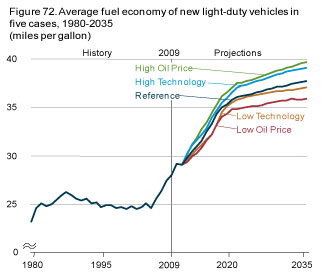 figure dataThe National Highway Traffic Safety Administration (NHTSA) introduced new attribute-based CAFE standards for MY 2011 LDVs in 2009, and in 2010 NHTSA and The U.S. Environmental Protection Agency (EPA) jointly announced CAFE and GHG emissions standards for MY 2012 to MY 2016. EISA2007 also requires that LDVs reach an average fuel economy of 35 mpg by MY 2020 [89]. In the Reference case, the average fuel economy of new LDVs (including credits for alternative fueled vehicles and banked credits) rises to 29.8 mpg in 2011, 33.3 mpg in 2016, and 35.8 mpg in 2020 (Figure 72). After 2020, CAFE standards for LDVs remain constant in the Reference case, and LDV fuel economy increases only moderately, to 37.8 mpg in 2035.
figure dataThe National Highway Traffic Safety Administration (NHTSA) introduced new attribute-based CAFE standards for MY 2011 LDVs in 2009, and in 2010 NHTSA and The U.S. Environmental Protection Agency (EPA) jointly announced CAFE and GHG emissions standards for MY 2012 to MY 2016. EISA2007 also requires that LDVs reach an average fuel economy of 35 mpg by MY 2020 [89]. In the Reference case, the average fuel economy of new LDVs (including credits for alternative fueled vehicles and banked credits) rises to 29.8 mpg in 2011, 33.3 mpg in 2016, and 35.8 mpg in 2020 (Figure 72). After 2020, CAFE standards for LDVs remain constant in the Reference case, and LDV fuel economy increases only moderately, to 37.8 mpg in 2035.
In the Reference case, cars represent 65 percent of LDV sales in 2035, compared with 69 percent in the High Oil Price case and 55 percent in the Low Oil Price case. The economics of fuel-saving technologies improve in the High Technology and High Oil Price cases, but the effects on average fuel economy relative to the Reference case are tempered by the fact that CAFE standards already require significant improvement in fuel economy performance and the penetration of advanced technologies.
Travel demand for personal vehicles increases more slowly than in the past
Personal vehicle travel demand, measured as VMT per licensed driver, grew at an average annual rate of 1.1 percent between 1970 to 2007, driven by rising income, a decline in the cost of driving per mile (determined by both fuel economy and fuel price), and demographic changes (such as women fully entering the workforce). Since 2007, VMT per licensed driver has declined slightly because of the sudden spike in the cost of driving per mile followed by the economic downturn. However, VMT per licensed driver begins to grow again in the Reference case, but at a more moderate average annual rate of 0.6 percent, reaching over 15,280 miles in 2035 (Figure 73).
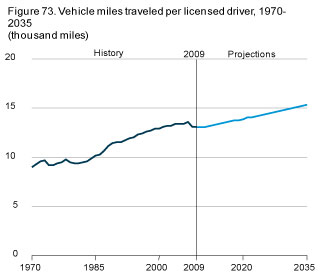 figure dataThe projected growth in VMT per licensed driver results from a return to rising real disposable personal income, which increases by 90 percent between 2009 and 2035. While motor gasoline prices rise by 60 percent over the period, faster income growth ensures that the impact on travel demand is blunted by a reduction in the percentage of income spent on fuel. In addition, the effect of rising fuel costs is moderated by a 30-percent improvement in new vehicle fuel economy following the implementation of more stringent GHG and CAFE standards for LDVs.
figure dataThe projected growth in VMT per licensed driver results from a return to rising real disposable personal income, which increases by 90 percent between 2009 and 2035. While motor gasoline prices rise by 60 percent over the period, faster income growth ensures that the impact on travel demand is blunted by a reduction in the percentage of income spent on fuel. In addition, the effect of rising fuel costs is moderated by a 30-percent improvement in new vehicle fuel economy following the implementation of more stringent GHG and CAFE standards for LDVs.
Several demographic forces also play a role in moderating the growth in VMT per licensed driver despite the rise in real disposable income. Although LDV sales increase through 2035, the number of vehicles per licensed driver remains relatively constant (at just over 1). In addition, unemployment remains above pre-recession levels in the Reference case until late in the projection period, further tempering the increase in personal travel demand.
New technologies promise better vehicle fuel efficiency
The market adoption of advanced technologies in conventional vehicles facilitates the improvement in fuel economy that is necessary to meet more stringent CAFE standards through MY 2020 and reduce fuel costs thereafter. In the AEO2011 Reference case, the CAFE compliance of new LDVs rises from 29.1 mpg in 2009 to 35.8 mpg in 2020 and 37.8 mpg in 2035, due in part to greater penetration of unconventionally fueled vehicles and in part to the addition of individual technologies in conventional vehicles (Figure 74).
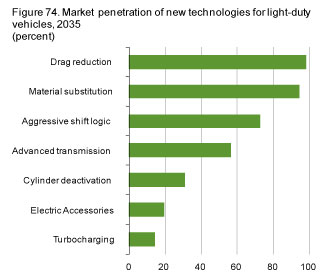 figure dataIn 2035, advanced drag reduction, which provides fuel economy improvements by reducing vehicle air resistance at higher speeds, is implemented in 98 percent of new LDVs. In addition, with the adoption of light-weight materials through material substitution, the average weights of new cars and light trucks decline by 4.9 percent and 1.5 percent, respectively, from 2009 to 2035, providing additional improvements in fuel economy.
figure dataIn 2035, advanced drag reduction, which provides fuel economy improvements by reducing vehicle air resistance at higher speeds, is implemented in 98 percent of new LDVs. In addition, with the adoption of light-weight materials through material substitution, the average weights of new cars and light trucks decline by 4.9 percent and 1.5 percent, respectively, from 2009 to 2035, providing additional improvements in fuel economy.
Advanced transmission technologies also improve fuel economy by improving the efficiency of vehicle drive trains. Aggressive shift logic is used in 73 percent of new LDVs in 2035; and other advanced technologies, such as continuously variable, automated manual, and six-speed transmissions, are installed in 56 percent of new conventional vehicles.
Engine technologies that reduce fuel consumption also penetrate the market for new vehicles. Cylinder deactivation and turbocharging reach penetrations of 31 and 14 percent, respectively, in 2035. Electrification of accessories such as pumps and power steering, which also increases fuel economy, is implemented in 19 percent of new LDVs in 2035.
Unconventional vehicle technologies exceed 40 percent of new sales in 2035
Unconventional vehicles (those that use diesel, alternative fuels, and/or hybrid electric systems) play a significant role in meeting more stringent fuel economy standards and offering fuel savings in the face of relatively higher fuel prices, growing from 15 percent of new vehicle sales in 2009 to 42 percent by 2035 in the AEO2011 Reference case.
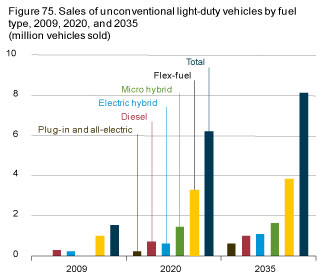 figure dataFlex-fuel vehicles (FFVs), which can use blends of ethanol up to 85 percent, represent the largest share of unconventional LDV sales in 2035, at 19 percent of total new vehicle sales and 47 percent of unconventional vehicle sales (Figure 75). Manufacturers selling FFVs currently receive incentives in the form of fuel economy credits earned for CAFE compliance through MY 2016. FFVs also play a critical role in meeting the RFS for biofuels.
figure dataFlex-fuel vehicles (FFVs), which can use blends of ethanol up to 85 percent, represent the largest share of unconventional LDV sales in 2035, at 19 percent of total new vehicle sales and 47 percent of unconventional vehicle sales (Figure 75). Manufacturers selling FFVs currently receive incentives in the form of fuel economy credits earned for CAFE compliance through MY 2016. FFVs also play a critical role in meeting the RFS for biofuels.
Sales of electric and hybrid vehicles that use stored electric energy grow considerably in the Reference case. Micro hybrids, which use start/stop technology to manage engine operation while at idle, account for 8 percent of all conventional gasoline vehicle sales by 2035, the largest share for vehicles that use electric storage. Gasoline-electric and diesel-electric hybrid vehicles account for 5 percent of total LDV sales and 13 percent of unconventional vehicle sales in 2035, and plug-in and all-electric hybrid vehicles account for 3 percent of LDV sales and 8 percent of unconventional vehicle sales. Sales of diesel vehicles also increase, to 5 percent of total LDV sales and 13 percent of unconventional vehicle sales in 2035. Light duty natural gas vehicles account for less than 0.1 percent of new vehicle sales throughout the projection due to their high incremental cost and limited fuel infrastructure.
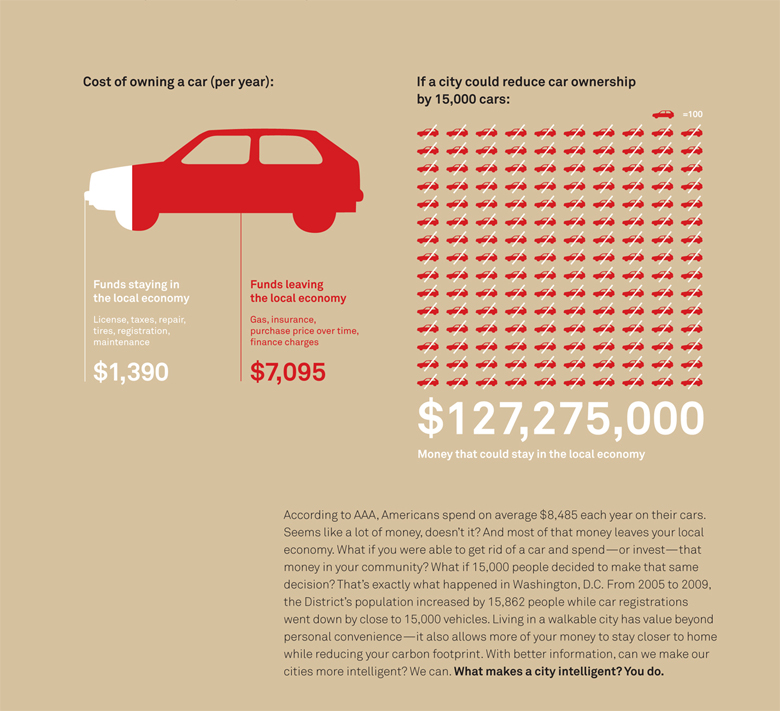







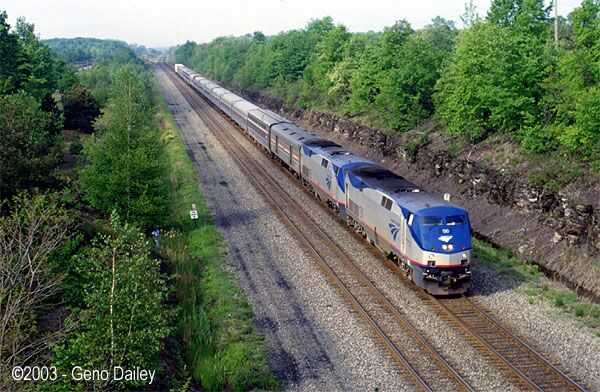


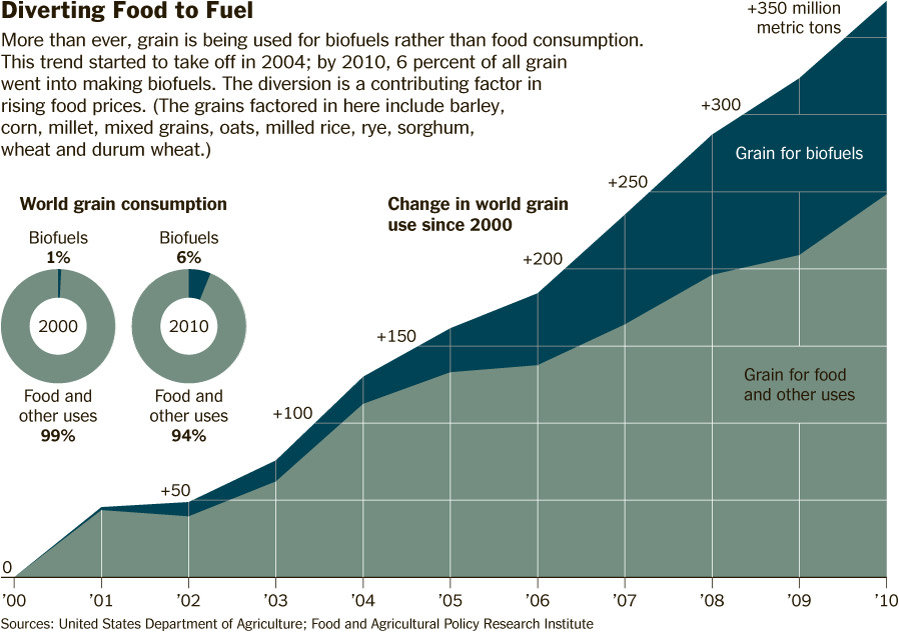


 Cities worldwide are demonstrating innovation in transport planning by integrating bike, BRT and metro systems, with
Cities worldwide are demonstrating innovation in transport planning by integrating bike, BRT and metro systems, with 
